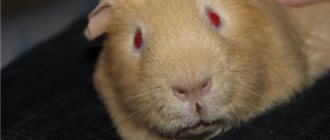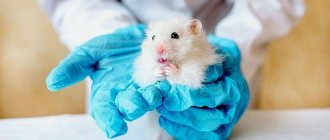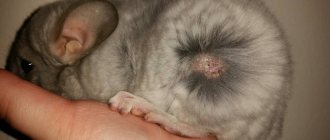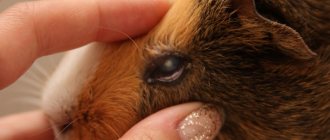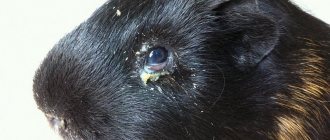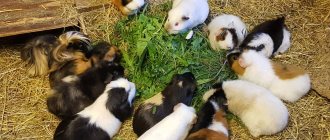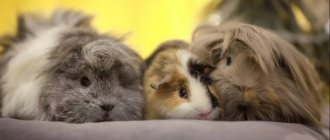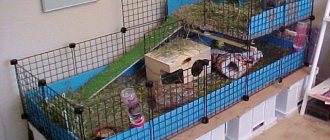- home
- Guinea pig
- Guinea pig health
02/14/2019 Every animal owner is faced with the phenomenon of shedding. It is important to distinguish between natural hair loss and a symptom of disease. If the owner knows when guinea pigs shed and what causes this process, he will be able to take care of his pet and provide him with the necessary help. Please remember that the information offered is not a substitute for visiting a veterinarian who has the resources to make an accurate diagnosis.
Causes of hair loss
Hair loss in guinea pigs is caused by the following reasons:
- Lack of vitamins C and B. Often occurs in winter, due to the limited amount of fresh fruits and vegetables.
- Stress: Causes hair dullness, hair loss, and gray hair. Caused by various reasons - moving, the appearance of new people or animals, loud sounds and other factors.
- Allergy.
- Fungus. The most dangerous is ringworm.
- Skin parasites: fleas, ticks, lice, lice.
In addition, the cause of local hair loss is physical trauma - a burn (including chemical), cut or bruise. After the wound heals, the fur will grow back on its own.
Trimming claws.
Caring for your guinea pig's claws You must ensure that the claws are not too long or sharp. The presence of long claws prevents the pig from moving
Claws should be trimmed only in cases of extreme necessity and very carefully. In this case, you should use special sharp scissors or forceps.
During the procedure, be sure to ensure that the skin is not damaged. If the claws are not very long, then you can remove the excess using an ordinary nail file. All these operations do not have to be done by the owners of the animals themselves. It is quite possible to entrust this to specialists.
Tags Guinea pig
Shedding without pathology
Guinea pigs molt in spring and fall. In September, the pet’s body tolerates it without interference, since the summer diet is full of fresh herbs and vegetables. Spring molting occurs in February and requires vitamin supplements in the diet. In addition, juvenile molting occurs in young individuals - a change from “childish” hair to “adult” hair. It is one-time and will not be repeated.
At home, the temperature in the apartment does not change significantly, so the pigs constantly shed a small amount of hair. If the process is not accompanied by alarming symptoms, such prolapse is safe. With age, wool grows in greater quantities. This is due to changes in the body. In addition, older animals spend less time caring for their fur.
Gilts are characterized by “bare” areas of skin behind the ears, provided that there are no peeling or wounds in these areas.
Preventative examination.
In order to carry out a preventive examination, it is necessary to observe the animal for three or four days, as well as directly examine the animal.
If the health of your ward is in perfect order, then this is manifested by a good appetite, mobility, and shiny coat without bald spots. In this case, there should also be no wounds, diarrhea, wheezing when breathing, runny nose, or pus in the eyes. With regular examination, there is a high probability of identifying any disease at an earlier stage and, accordingly, allowing appropriate measures to be taken.
The pig just needs to be given movement. To do this, you need to occasionally let her out of the cage for a walk around the house.
In this case, the owner should be careful not to inadvertently damage the animal with doors or feet. And also, we should not forget that an animal left unattended can chew your furniture a little
If there are other animals in the room, in addition to the rodent, that can harm it, then they should be eliminated while the pig is walking. If there is a need to pick up a pig, you should do it in a special way. It is necessary to grab the back and chest of the animal with a sharp, decisive movement of the hand, while holding the butt with the other hand. Under no circumstances should you carry pregnant females or newborn pigs in your arms.
Lack of vitamins
Lack of vitamins is a relatively painless reason why your guinea pig sheds. In addition to baldness, there are no other unusual symptoms: the animal is active, has a good appetite, does not itch, and there are no redness or wounds on the body. For treatment, fresh vegetables and herbs are added to the diet: dill, parsley, carrots. Regular hay is replaced with clover or legume hay. Additionally, ascorbic acid is added to drinking water (20 mg per day is enough). Pet stores sell special complexes of microelements - calcium, phosphorus, vitamin C. Particular attention should be paid to the pet during seasonal molting and immediately after pregnancy, when the animal’s body is weakened.
It is not recommended to leave vitamin deficiency without treatment: the pet’s immune system weakens, which opens access to dangerous infections in the body.
Why do guinea pigs shed?
Shedding is a natural process during which new fur grows in place of the lost fur. Coat change can be seasonal or juvenile (age-related). If the animal is kept in good conditions and eats properly, then molting usually takes place without any negative consequences.
But it happens that this process is not associated with natural causes. It can be caused by poor diet and lack of vitamins in food, improper living conditions, stress, pet illness or parasites.
Attention! If your pet's fur is actively falling out throughout the year, bald patches appear, the skin turns red and peels, pay attention to these symptoms. The animal needs treatment or changes in living conditions.
Fungal diseases
The most common infections in pigs are lichen and dermatophytes. Symptoms of lichen:
- hair falls out in clumps;
- itching;
- skin redness;
- purulent wounds (in later stages);
- dandruff appears.
Ringworm is contagious to people and animals. If this disease is detected in the room, a wet cleaning is carried out and the cage and all objects used by the pet are disinfected.
With ringworm, the animal's skin peels off and bald spots appear on the head. Over time, the disease spreads to the neck, paws and other parts of the body. Infection occurs through low-quality food or items brought from the street. The infection is often “brought” into the house on shoes or clothing.
Nizoral shampoo is suitable for treatment. In just a few procedures, it removes itching and inflammation. Apply it to sore spots for 5-7 minutes, then wash off with warm water. It is not recommended to bathe a pig entirely - they do not like water treatments. You can also use Fungoterbin and Thermikon creams (one percent). As a last resort, you can purchase Castellani or Fukortsin.
Electric models
Beginners should pay attention to more innovative gadgets. They are definitely a little more expensive
But in this case, the price increase proportionally affects safety.
We are talking about a family of rechargeable machines equipped with a rotating head. They do not cut, but grind down the cornea. With this approach, it is almost impossible to harm a dog or cat by catching too much of a nail. The high rotation speed of the tip ensures fast operation, and the low noise level does not bother four-legged patients at all. Any beginner can easily cope with such a mechanism.
Price – 481 – 1,859 rubles.
Some models are equipped with 2-3 heads, suitable for dogs or cats of various breeds and age groups.
After all, the claws of a dwarf poodle are much more delicate than those of a German shepherd. The same applies to young kittens and adult cats - their paws need to be treated with different elements. So, when purchasing a tool for trimming claws, you should consider this nuance.
Cost – 567 – 1,189 rubles.
The final touch is the rotation speed of the device head.
It directly affects the quality of claw grinding. After all, it is necessary not only to cut off the ends, but also to polish the ends so that the sharp edges do not injure the delicate pads of the paws. This operation is best done in a more gentle mode at low speeds. So a machine with gear shifting will come in very handy in this case.
Price – 497 – 1,566 rubles.
I like it I don't like it
Diseases caused by skin parasites
Sometimes skin parasites penetrate the fur, causing guinea pigs to shed. Common causes of parasites:
- poor quality feed or hay;
- dirty bedding;
- appearance of infected animals;
- walking through dirty places on the street.
Cats are usually carriers of fleas. Fleas cause severe itching, and the pig scratches itself until there are bloody wounds, which are dangerous because they open up access to infections. If fleas are found, treat the pet and cage with cat shampoo. After two weeks, the procedure is repeated for prevention. The premises should also be disinfected.
Skin mites settle under the pet's skin, which they feed on. The parasites cause severe itching, which causes the guinea pig's hair to fall out. The animal constantly itches, loses sleep and appetite, which eventually leads to exhaustion and death. For treatment, subcutaneous injections of Ivermectin are used. The dosage is measured according to the instructions or as directed by the doctor.
Skin parasites can be seen with a magnifying glass. To accurately determine the disease, the pet is taken to a veterinarian, who will conduct the necessary tests and prescribe a course of treatment.
Pododermatitis
Pododermatitis is a fairly common phenomenon among rodents, characterized by a disease of the paws and otherwise called “painful heels.” Most often, the disease affects the guinea pig's hind limbs and hock joint.
Causes
The following factors contribute to the development of pododermatitis:
- Inappropriate conditions for keeping a piglet. Dampness and dirty litter are favorable soil for the proliferation of pathogenic bacteria.
- Excess weight of the pet, it puts additional stress on the paws.
- Low physical activity of the pig.
- Uneven, wire floor in the cage. If every step causes deformation of the animal's foot, it is likely to develop pododermatitis.
- Lack of certain vitamins, in particular vitamin C.
- Claws cut at the wrong time.
Then, without appropriate treatment, ulcers and wounds appear on the paw, the animal becomes lethargic and apathetic, and may even cry.
Treatment
It is very important to prevent the development of pododermatitis. That’s why clean the cage on time, use soft material for filler that will not injure your pet’s paws, and trim overgrown claws in a timely manner.
If it does develop into pododermatitis, be prepared that it will take quite a long time to treat it. The wounds on the paws are first treated with solutions of chlorhexidine or hydrogen peroxide.
Then Levomekol or Solcoseryl ointment is applied. Antibiotic therapy is sometimes required if the wounds are severe and threaten to develop into blood poisoning. In severe cases, an x-ray may be necessary to ensure the bone is intact.
Baldness caused by stress and allergies
Stress causes hair loss in pigs. Small animals are shy, so various factors serve as a source of concern:
- noise;
- moving;
- change of feed;
- the appearance of new people or animals;
- prolonged contact with a person.
To calm the animal, it is placed in a quiet, isolated place. Add more juicy foods and greens to the diet. Usually improvement occurs soon.
The allergy is manifested by sneezing and watery eyes. But sometimes it becomes the reason why a guinea pig’s hair falls out on its butt, sides or back. To eliminate symptoms, it is enough to identify the allergen and isolate your pet from it. To do this, the animal is replaced in turn with food or bedding material.
When to be wary
When a guinea pig makes strange noises, it can mean both positive and negative emotions. You need to study the character of the pet, see what happens to it
A screaming guinea pig tries to attract the attention of its owner. The animal has problems and there is no other way to convey this. Sounds that are alarming:
Sounds that are alarming:
- The pet squeaks loudly. If there is no one nearby, the paw is not stuck, and no other visible causes are found, the animal must be urgently taken to a veterinary clinic.
- An animal that can hear wheezing when breathing needs urgent medical attention.
- The animal is shown to the veterinarian when teeth grinding is heard. There may be serious dental problems that need to be addressed.
- The cry of a pet signals that he is uncomfortable and scared. The animal is cold or, on the contrary, hot, its stomach hurts, there has been no water in the drinking bowl for a long time, it is tormented by thirst.
Each pet is individual. There are pigs who violently express emotions, squealing with joy at every occasion. Others may rumble quietly in the same situation. The owner’s task is to listen to the sounds the animal makes. If you are attentive, you can recognize what your pet’s mood is and what it wants.
In this article, I will describe the possible reasons for a guinea pig squeaking loudly when you try to pick it up or pet it, why its teeth chatter and squeak when you pet it. Often, inexperienced owners are frightened by the sounds made by the animal, believing that the pig is sick with something. In fact, the animal communicates its needs and emotions to humans.
Home remedies for nasal congestion
Home remedies can help when you experience nasal congestion. However, do not self-medicate - consult a therapist.
Humidifiers, which add moisture to the air, can help break up mucus and soothe sore nasal passages. However, if you have asthma, ask your doctor before using a humidifier.
Propping your head with pillows can also stimulate the flow of mucus from your nasal passages.
Saline sprays are safe for all ages, but for children you will need to use an aspirator or nasal bulb. An aspirator is used to remove any remaining mucus from the baby's nose.
New growths on the skin
Tumors in guinea pigs are rare, but, of course, sometimes it is the neoplasm that causes a visit to the veterinary clinic.
What could it be?
As a rule, the owner may suspect a tumor in his guinea pig if he notices a strange lump on the pet’s body or a non-healing wound. However, the neoplasm is not always malignant. This may be an abscess - a purulent capsule resulting from an injury. A lipoma, a benign formation consisting of fat cells, can also develop on the body of a guinea pig. Lipoma grows slowly and does not pose a threat to the pet’s life; it looks like a lump with moving contents.
In principle, a benign tumor can be distinguished by its growth rate and structure. The benign formation grows slowly and is located, as it were, on a stalk, at some distance from the skin. Cancer most often looks like an unhealed wound rather than a lump. It affects the skin on the paws, less often on the back or sides.
Treatment
To treat an abscess, Vishnevsky or Ichthyol ointments are used. They contribute to the rapid “ripening” of a purulent wound, which, after opening, is cleaned of pus and disinfected. Tumors, of course, need to be removed surgically. Moreover, it is also advisable to remove a benign lipoma, because there is always a risk that it will develop into a malignant liposarcoma. With timely surgical intervention, 70% of cases result in a complete cure.
What should be of concern?
From time to time it is worth examining the fur and skin of the animal to see if it is combed (sometimes until it bleeds), if dandruff, bald spots, peeling, and skin parasites are observed.
Don't be alarmed by the sight of bald patches behind the ears and on the inside of the front legs - this is a normal appearance for all pigs.
If these symptoms occur, the most logical thing to do is urgently do an appropriate test - a scraping - to identify parasites and fungus on the skin.
Bathing.
bathing a guinea pig If there is a need to bathe a pig (and this should only be done in rare cases), then it is better to use warm water and baby shampoo. After bathing, the animal should be dried with a towel and placed in a room protected from drafts. This is due to the fact that after water procedures the pig can easily catch a cold. You can bathe a pig only if it is simply impossible to do without this procedure. For example, if the fur around the anus is dirty due to bowel movements due to diarrhea or the animal is very dirty in the ground.
Trixacarosis
The disease is caused by mites that infect the inner layers of the skin. Symptoms of infection are rough skin, baldness, redness and dry crusts. If treatment is not carried out at the initial stage, then purulent painful ulcers form at the site of redness. The disease is accompanied by severe itching. The animal becomes restless, the temperature may rise and loss of appetite may occur. The disease is diagnosed exclusively by skin scraping. Treatment depends on the stage of the disease.
Demodicosis
Demodicosis is very similar to the previous disease and is caused by mites that parasitize the inner layers of the skin.
Purulent ulcers form at the site of the lesion. During the illness, the guinea pig sheds heavily, refuses to eat, and has an increase in body temperature and anxiety. If treatment is not started in time, the guinea pig may die from exhaustion. Demodicosis is dangerous because it can be transmitted to humans. Handle an infected animal only while wearing gloves. The disease is diagnosed by skin scraping in a veterinary clinic.
Symptoms of androgenetic alopecia in women
The success of treatment for androgenetic alopecia in women is closely related to the extent of the damage. Doctors at the HFE Clinic recommend contacting them at the first signs of the disease, and in the case of hereditary baldness, in advance, before hair begins to fall out quickly. But an important feature of this type of disease is its inconspicuous onset. Many patients turn to doctors at the moment when the bald spot is clearly visible and only a transplant can help. The first signs are missed - women consider the large number of hairs remaining on the comb to be a seasonal phenomenon or explain it as improper care.
The process of the appearance of noticeable bald spots takes a long time: several years may pass from the onset of the disease to the moment when panic begins. But there are several symptoms that show that the pathology has already begun and it’s time to see a doctor:
- hair becomes thin, hair volume is lost, strands grow slowly or break off;
- On the parting, thinning of the strands is noticeable. The hairs at the parting site become thin and fluffy, and the parting visually expands. The same thing happens with the strands at the temples;
- Dandruff and dry scalp appear. At the next stage, dandruff disappears, replaced by seborrhea;
- In appearance, the hair becomes less vibrant, brittle, dull, and the strands feel dry to the touch. At the seborrheic stage, the picture changes: the strands always look unkempt, as if they haven’t washed their hair for a long time;
- the structure of the hairs changes. Strong long hair is replaced with short, fluff-like strands.
The development of the disease is especially noticeable on the top of the head, at the parting site. First, vellus hairs appear on the parting, through which the scalp is visible, then they fall out, and a bald spot forms. The disease can also affect eyebrows and eyelashes. But on the body and face, on the contrary, unwanted hair may appear.
You should consult a doctor in the first stages of the disease, especially if fortified and strengthening masks and shampoos do not bring results. The sooner the doctor makes a diagnosis, the higher the chance of delaying the visible signs of androgenic alopecia.
